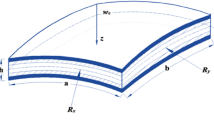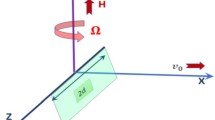Abstract
In this paper we investigated a radially polarized piezoceramic cylinder with graded piezoelectric properties, and used a nonlinear model for piezoceramics subjected to high electric fields. We investigated the nonlinear behavior of this material by examining changes in its electric-field-dependent dielectric and piezoelectric coefficients caused by domain wall motion. The Galerkin finite-element method was used to solve the governing equations of the axisymmetrically loaded heterogeneous piezoceramic medium subjected to harmonic electrical loading. Stress, displacement, resonance, and frequency responses were compared for homogeneous and graded cylinders; additionally, we compared the results of linear and nonlinear studies. We showed that the effective stress was higher within the graded cylinder than within the homogeneous cylinder, and that the nonlinearity caused by domain wall motion was less pronounced for the graded cylinder than for the homogeneous cylinder. The frequency responses of homogeneous and heterogeneous piezocylinders were also compared with those of piezoelectric plates. We concluded that—unlike for graded plates, which have a more desirable frequency response than homogeneous plates—graded cylinders are not superior to homogeneous cylinders. The finite-element solution in this paper is verified by simulations using COMSOL Multiphysics software.







Similar content being viewed by others
References
Birman V, Byrd LW (2007) Modeling and analysis of functionally graded materials and structures. Appl Mech Rev 60:195–216
Ray AK, Mondal S, Das SK (2005) Bamboo A functionally graded composite-correlation between microstructure and mechanical strength. J Mater Sci 40:5249–5253
Genin GM, Kent A, Birman V, Wopenka B, Pasteris JD, Marquez PJ, Thomopoulos S (2009) Functional grading of mineral and collagen in the attachment of tendon to bone. Biophys J 97:976–985
M. Koizumi, “The concept of FGM”, In: B. Holt, M. Koizumi, T. Hirai, and Z.A. Munir (eds.), Ceram. Trans. 34, Functionally Gradient Materials, pp. 3–10. Westville: American Ceramic Society 1993
K. Yamada, D. Yamazaki, and K. Nakamura, “A functionally graded piezoelectric material created by an internal temperature gradient”, In: Proceedings of the 12th IEEE International Symposium on Applications of Ferroelectrics, pp. 475–478, Honolulu, HI, USA, 2000
Takagi K, Li JF, Yokoyama S, Watanabe R, Almajid A, Taya M (2002) Design and fabrication of functionally graded PZT/Pt piezoelectric bimorph actuator. Sci Technol Adv Mater 3:217–224
Yang J, Jin Z, Li J (2008) Functionally graded piezoelectric materials for modal transducers for exciting bulk and surface acoustic waves. IEEE Trans Ultrason Ferroelectr Freq Control 55:1555–1558
Ichinose N, Miyamoto N, Takahashi S (2004) Ultrasonic transducers with functionally graded piezoelectric ceramics. J Eur Ceram Soc 24:1681–1685
Hall DA (2001) Nonlinearity in piezoelectric ceramics. J Mater Sci 36:4575–4601
Jiangong Y, Bin W, Guoqiang C (2009) Wave characteristics in functionally graded piezoelectric hollow cylinders. Arch Appl Mech 79:807–824
Li XF, Peng XL, Lee KY (2010) Radially polarized functionally graded piezoelectric hollow cylinders as sensors and actuators. Eur J Mech Solid 29:704–713
Han X, Liu GR (2003) Elastic waves in a functionally graded piezoelectric cylinder. Smart Mater Struct 12:962–971
Yamada K, Sakamura J, Nakamura K (2001) Equivalent network representation for thickness vibration modes in piezoelectric plates with a linearly graded parameter. IEEE Trans Ultrason Ferroelectr Freq Control 48:613–616
Yamada K, Sakamura J, Nakamura K (2000) Equivalent network representation for thickness vibration modes in piezoelectric plates with an exponentially graded parameter. Jpn J Appl Phys 39:L34–L37
Rubio WM, Buiochi F, Adamowski JC, Silva ECN (2009) Modeling of functionally graded piezoelectric ultrasonic transducers. Ultrasonics 49:484–494
Kittle C (1951) Domain boundary motion in ferroelectric crystals and the dielectric constant at high frequency. Phys Rev 83:458
Arlt G, Dederichs H (1980) Complex elastic, dielectric and piezoelectric constants by domain wall damping in ferroelectric ceramics. Ferroelectrics 29:47–50
Narita F, Shindo Y, Mikami M (2005) Analytical and experimental study of nonlinear bending response and domain wall motion in piezoelectric laminated actuators under AC electric fields. Acta Mater 53:4523–4529
Shindo Y, Narita F, Nakagawa J (2009) Dynamic electromechanical response and self-sensing of functionally graded piezoelectric cantilever transducers. J Intell Mater Syst Struct 20:119–126
Shindo Y, Narita F, Mikami M, Saito F (2006) “Nonlinear dynamic bending and domain wall motion in functionally graded piezoelectric actuators under ac electric fields: simulation and experiment”, JSME Int. J Solid Mech Mater Eng 49:188–194
Shindo Y, Narita F, Nakagawa J (2007) Nonlinear bending characteristics and sound pressure level of functionally graded piezoelectric actuators under AC electric fields: simulation and experiment. Smart Mater Struct 16:2296–2301
Hynynen K, Dennie J, Zimmer JE, Simmons WN, He DS, Marcus FI, Aguirre M (1997) Cylindrical ultrasonic transducers for cardiac catheter ablation. IEEE Trans Biomed Eng 44:144–151
Parton VZ, Kudryavtsev BA (1988) Electromagnetoelasticity of solids: piezoelectrics and electrically conductive materials. Gordon and Breach Science Publishers, Amsterdam
Tiersten HF (1984) Linear theory of piezoelectricity. IEEE Trans Son Ultrason 31:10–13
Li S, Bhalla AS, Newnham RE, Cross LE (1993) Quantitative evaluation of extrinsic contribution to piezoelectric coefficient in ferroelectric PZT ceramics. Mater Lett 17:21–26
Yang Y (2005) An introduction to the theory of piezoelectricity. Springer, Berlin
Eslami MR (2003) A first course in finite-element analysis. Tehran Publication Press, Tehran
Acknowledgments
The authors thank Dr. Philip Weetman from the Center for Smart Materials & Structures at the Royal Military College of Canada for his constructive comments and discussions about this research. We also thank the Canadian Department of National Defence for its financial support.
Author information
Authors and Affiliations
Corresponding author
Appendix
Appendix
The constitutive relations needed for thickness-vibration analysis of a one-dimensional piezoelectric plate polarized and graded in the thickness direction and constrained from in-plane motion are given by the following relations:
where \( z \) is the thickness coordinate and \( u \) is the displacement in the thickness direction.
Substituting the previous equation in (2) and considering the lack of shear stress in this problem, the governing equations are:
The boundary conditions of the problem are similar to those of the cylinder:
where \( h \) is the plate thickness.
Rights and permissions
About this article
Cite this article
Babaei, M.H., Akhras, G. Graded piezoelectric cylinders subjected to high electric fields and comparison of their frequency response with piezoelectric plates. Meccanica 49, 1527–1538 (2014). https://doi.org/10.1007/s11012-014-9935-8
Received:
Accepted:
Published:
Issue Date:
DOI: https://doi.org/10.1007/s11012-014-9935-8




